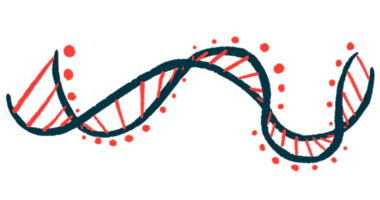MG Genetic Risk Factor Directly Tied to Neuromuscular Junction Identified

For the first time, a genetic risk factor for myasthenia gravis (MG) has been identified that involves a gene — AGRN — coding for a protein directly involved in the activity of neuromuscular junctions (NMJs), which are impaired in MG, researchers report.
The study, involving the genetic analysis of more than 1,000 MG patients and 3,500 healthy individuals of European ancestry, also confirmed the protective or damaging effects of genetic variants previously associated with MG.
Data also highlighted a distinct genetic architecture between early and late-onset MG, and significant genetic associations between MG and other autoimmune diseases, suggesting similar underlying mechanisms.
The study, “Myasthenia gravis genome-wide association study implicates AGRN as a risk locus,” was published in the Journal of Medical Genetics.
In MG, the immune system produces self-reactive antibodies that mistakenly attack proteins that facilitate nerve-muscle communication at the neuromuscular junction, leading to muscle weakness and fatigue. (The NMJ is the point of contact between nerve cells and the muscles they control, and where nerve-muscle communication takes place.)
This rare autoimmune condition is caused by a complex interaction between genetic and environmental factors. To date, some genetic risk factors have been identified, including mutations in genes of the human leucocyte antigen (HLA) complex, as well as in TNFRSF11A and CTLA4.
The HLA system is a set of proteins that denote genetic variations in an individual’s immune system. TNFRSF11A provides the instructions to produce a protein involved in the maturation of certain immune cells, while CTLA4 codes for a protein that helps to keep immune responses in check.
By conducting a genome-wide association study (GWAS) of the largest MG genetic data set analyzed to date, a team of researchers in the U.S., Greece, and Cyprus identified a new genetic risk factor of MG.
GWAS enabled the researchers to scan complete sets of genes’ DNA, or genomes, of a large number of people to identify all the genetic variants associated with the development of a particular disease, and their different effects on the risk of developing the disorder.
The GWAS meta-analysis integrated three different data sets, covering 1,401 people with MG and 3,508 neurologically healthy individuals, all of European ancestry.
Analysis confirmed specific variants in the HLA-DQA1 and TNFRSF11A genes as the top genetic risk factors for MG, as well as the previously reported association between CTLA4 mutations and MG.
Other genetic mutations in HLA-DRB1 and HLA-B were found to be significantly associated with either a high risk of developing MG, or a protective effect against the condition, consistent with previous studies.
Notably, the analysis also identified the rs3128125 variant in the AGRN gene as a risk factor for MG — representing the first association with a gene directly linked with NMJ structure and activity.
The AGRN gene provides instructions to produce agrin, a protein that promotes the stabilization and activation of the neuromuscular junction through processes involving acetylcholine receptors and muscle-specific tyrosine kinase, two of the most common NMJ proteins targeted by self-reactive antibodies in MG.
Interestingly, AGRN mutations were previously identified as a rare cause of congenital MG, and antibodies against agrin have also been detected in MG patients.
Researchers then focused on assessing the genetic differences between patients with early onset MG (EOMG; disease onset before age 50) and late-onset MG (LOMG; disease onset after age 50).
They found the rs4369774 variant in the TNFRSF11A gene was the greatest risk factor for LOMG, while the rs9271539 variant — located between HLA-DQA1 and HLA-DRB1 — was the most protective against this disease form.
Also, a new genetic variant, called rs8058928, in a region that lies between the SRCAP and FBRS genes, was found to be protective against EOMG, as was the rs9262202 variant located in the HLA region. Of note, the SRCAP gene is involved in immune-related processes and muscle maturation.
Together, these findings strongly support “the involvement of previously identified [risk factors], including HLA, TNFSRF11A and CTLA4, and [underly] the fact that a different genetic architecture may distinguish EOMG from LOMG,” the researchers wrote.
Variations at specific genes may predispose a person to MG, “on which different environmental, hormonal and sex-specific factors determine each subgroup’s susceptibility to disease onset and severity,” they wrote.
Given that 15% of MG patients have another autoimmune disorder, the scientists also analyzed publicly available European ancestry GWAS data sets for 13 other autoimmune diseases. Their goal was to assess potential genetic associations with MG.
They found that MG was significantly associated with type 1 diabetes, rheumatoid arthritis, autoimmune thyroid disease, and late-onset vitiligo, even when the HLA region was excluded from the analysis.
Moreover, they found several common risk factors between MG and each of these four other autoimmune disorders, with most of them having already been associated with the other condition.
Notably, two new risk factors were identified between MG and either late-onset vitiligo (a condition affecting the skin’s pigment cells) or rheumatoid arthritis.
These data point to shared underlying genetic mechanisms between MG and these four autoimmune diseases.
While this represented the largest MG GWAS meta-analysis conducted to date, “larger sample sizes of individual subgroups will be required for genetics to provide a robust explanation for their distinct immunological, histological and epidemiological characteristics,” the researchers concluded.







